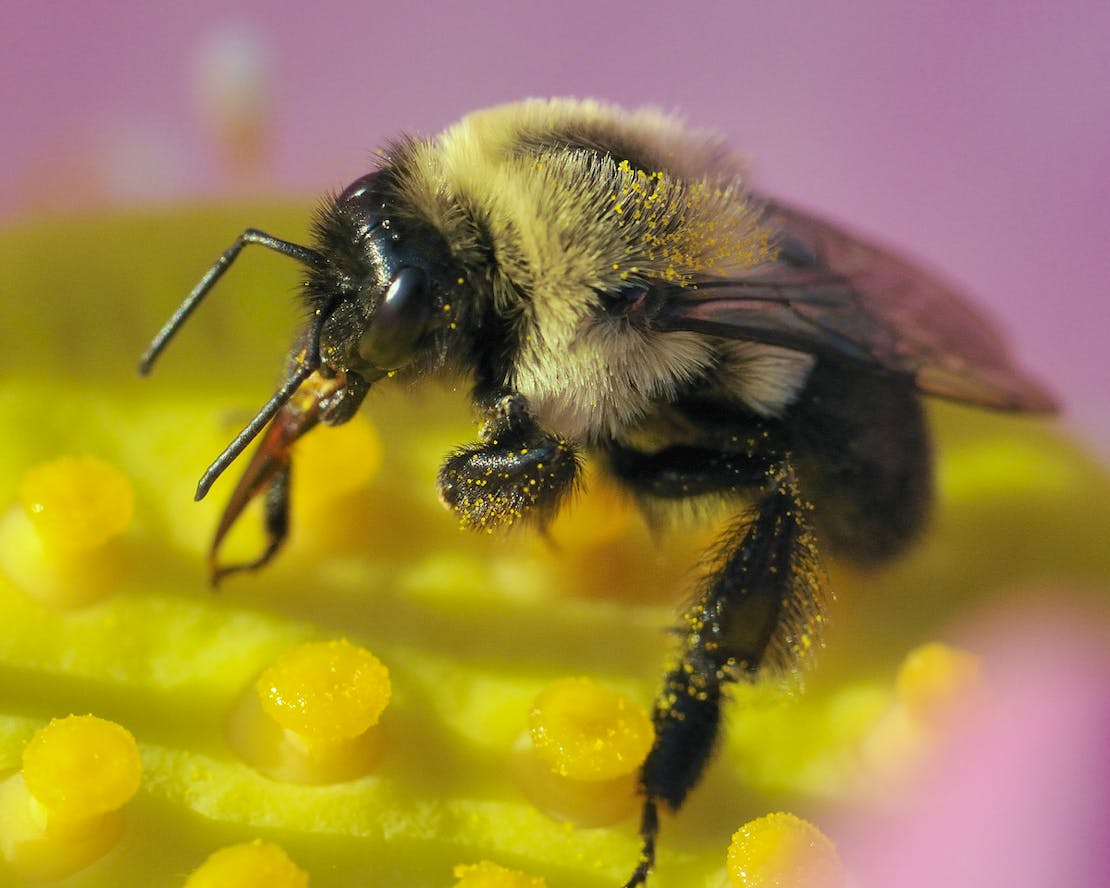Summer is a buzz with life. Butterflies have emerged from their chrysalis and moths from their cocoons. On the hunt for their next meal, birds take wing with the dawn, while bats dot the evening skies. Humble bumble bees dance from flower to flower seeking pollen to feed their larvae and themselves. All different creatures that share one trait: they are pollinators.
What is a Pollinator?
A pollinator is an animal – small mammal, bird or bug – that helps plants reproduce. Imagine a butterfly landing on a flower. As it gathers nectar from the base of the pollen-producing reproductive organ of the flower called the stamen, it becomes covered in pollen. The butterfly then flies to the next flower, bringing the pollen with it and shaking it onto this flower’s female counterpart, the stigma. The result: a fertilized flower that will produce new fruit and seeds.
What does this mean for people? About one in every three bites of food we consume is dependent on pollinators. In fact, native bees alone provide over $5 billion in crop pollination services annually in the United States.
Do Pollinators Move Pollen Intentionally?
Butterflies, bats, wasps and birds all visit flowers in search of food or nest building materials and as a result are accidental pollinators. Bees, however, collect pollen intentionally, as it is a source of protein and nutrients they and their hives depend on to sustain life.
What Season are Pollinators Most Active?
Pollinators are at work year-round. Think about how some foods are more in season during different times of the year. To decrease competition between pollinators, plants evolved with different flowering times throughout the year.
In the spring, early blooming plants provide food for pollinators coming out of hibernation or gearing up to migrate. For example, Native Woodland Phlox (Phlox divaricate) and Wild Pinks (Silene caroliniana) bloom in early to mid-spring while Asparagus is in season during the spring.
As the temperature rises into summer, pollinator populations and gardens peak. Longer days provide maximum foraging time. Some plants will still flower through the summer, yielding their fruit or seed later in the season or in fall. The native American bellflower (Campanula americana) will bloom throughout the summer. Native pale-leaved sunflowers (Helianthus strumosus) bloom in the late summer and into the fall.
Just as people harvest their fall crops, pollinators that hibernate or migrate fuel-up on late blooming plants during the autumn. For most pollinators, though, the fall’s leaf litter and decaying ground is just as important to their life cycles. Tree holes, fallen leaves, log nooks or rock crevices provide sleeping corridors for overwintering or serve as a nest for eggs. Grapes, squashes and cauliflower are all in season during the fall.
The native American Witchhazel (Hamamelis virginiana L.) blooms in the fall. While most plants don’t bloom in the winter, there are some that provide bright-colored berries for resident birds. These include native American Holly (Ilex opaca) and inkberry (Ilex glabra). Seasonal fruit and veggies, including grapefruit and leeks, are also produced in the winter. Read more about what happens to bees and butterflies during the winter in this blog.
Are Pollinators in Trouble?
The short answer: yes. Many native pollinator populations are in decline.
Habitat loss and fragmentation from development are major contributors to the problem. While, climate change significantly shifts temperatures and precipitation patterns, altering the distribution of plants and flowering times. Native pollinators, particularly bees, may be left with fewer opportunities to find nectar during harsh weather conditions and during times of the year when they typically rely on just a small handful of flowering plants. Finally, the widespread use of pesticides in agriculture and residential areas has increased the mortality pollinators. Additionally, the chemicals alter soil composition and quality when applied to plants.
What Would Happen If Pollinators Were to Disappear?
If pollinators disappeared, highly specialized crops – such as pears, blueberries and apples – that depend on pollinators to reproduce would be the first to go. Cacao and coffee beans would also quickly disappear.
The economic ramifications of pollinators’ disappearance would be staggering. Bee species alone pollinate 70 out of 100 crop species that feed some 90% of the world’s population. Decreasing agricultural output would collapse supply chains and likely create international conflicts as countries struggle to feed their people.
All in all, if pollinators disappeared, our world would become bland, lifeless and devoid of color.
How Can We Help Pollinators?
We can all help pollinators by fostering native plant life in our yards and communities. Shopping locally, and organically too, helps to support local pollinators and reduces our carbon footprint. Avoiding or limiting the use of chemical pesticides in gardens and yards can also help our pollinators.
The Endangered Species Act also protects some imperiled pollinators, like the rusty patched bumble bee, Honduran emerald hummingbird, Mission blue butterfly and northern long-eared bat. You can write to your representatives to protect the ESA and vote with wildlife in mind to voice your support for this critical law and all the species it protects and helps to restore.
And, if you are able, you can support organizations like Defenders of Wildlife that are working on Capitol Hill, in the courts and in the field to save the wildlife and wild places we all love.













